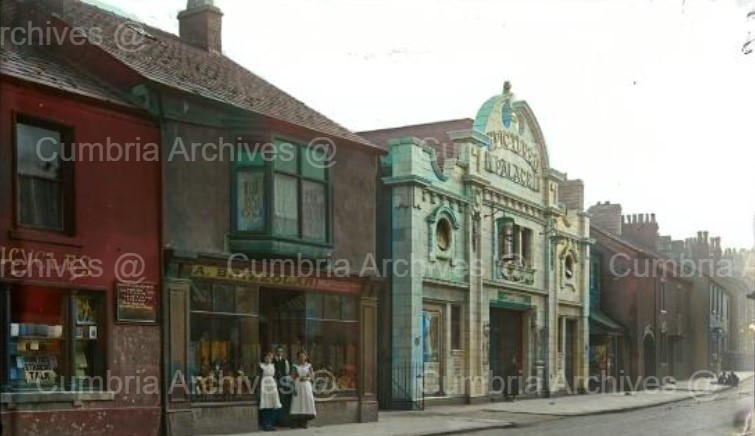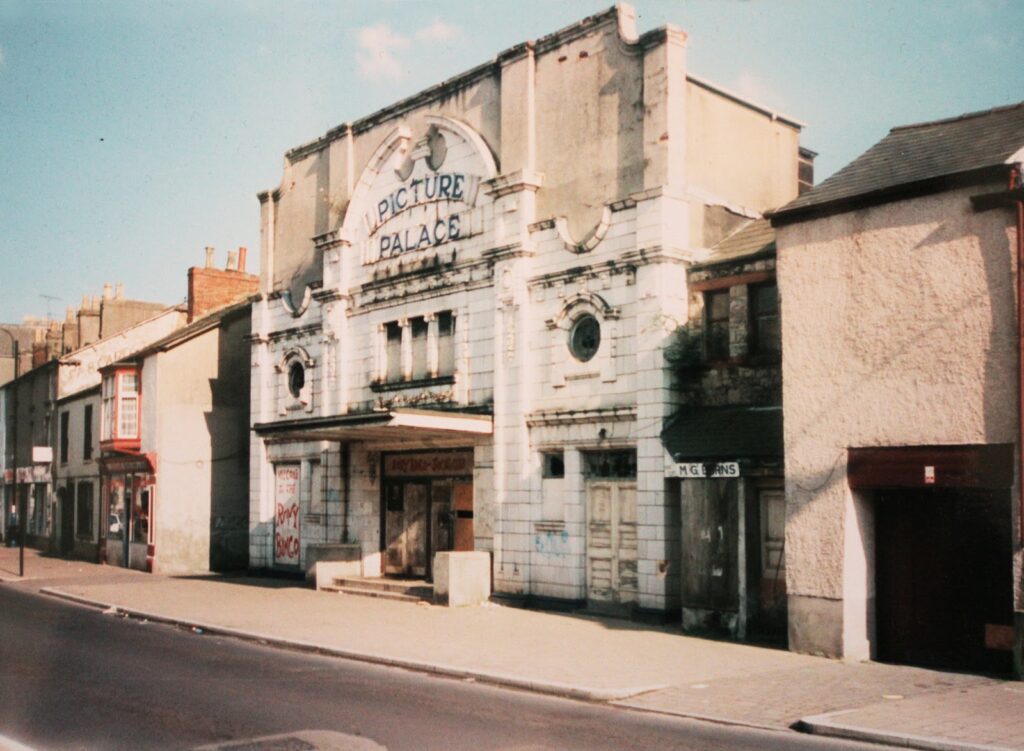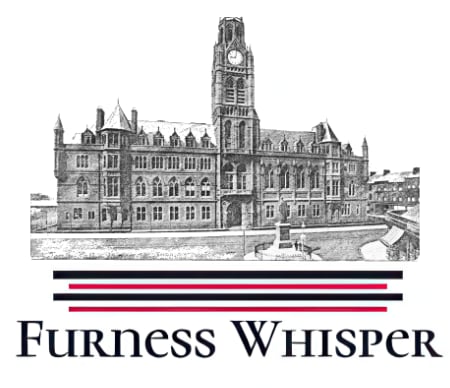

In the heart of Dalton-in-Furness, nestled on the bustling Market Street, stood a building that was far more than just a structure—it was a home for the community’s collective memories. For generations, the Roxy Cinema, later transformed into the Roxy Bingo Hall, was a place where Dalton’s residents came together to laugh, cry, and dream. Whether it was the soft murmur of excited chatter before the film began, the thrill of the bingo numbers being called, or the comforting familiarity of the building’s grand façade, the Roxy was a beloved constant in a rapidly changing world.
The story of the Roxy is one of transformation—a picture palace built in the early 1900s that evolved into a cinema and later a bingo hall, each incarnation reflecting the cultural shifts of the time. It was more than just a venue; it was a gathering place, a symbol of the town’s social life, and a testament to the entertainment of a bygone era. In this blog, we’ll take you on a journey through every chapter of the Roxy’s history, from its beginnings as the Empire Picture Palace in 1912, through its Art Deco revival as the Roxy Cinema in 1936, to its final days as a bingo hall before being demolished to make way for modern development. Join us as we remember this iconic building and the role it played in Dalton’s vibrant community.
Origins of the Empire Picture Palace (1912)
The story of the Roxy begins in 1912, when Dalton’s first purpose-built cinema, initially named the Empire Picture Palace, opened on Market Street. This cinematic venue replaced an older brewery on the site, which was owned by local entrepreneurs Mr. Backhouse and Mr. Drinkwater. The building’s design was typical of the early 20th-century “picture palaces”, combining grandeur with functionality to offer a rich cinematic experience for the public.
The façade of the Empire Picture Palace was particularly notable. Constructed with white glazed terracotta, it boasted an ornate, classical “Picture Palace” style, with a grand, curved central pediment and the words “PICTURE PALACE” prominently displayed. The white façade stood out against the darker brick buildings surrounding it, almost glowing in the sunlight. Inside, the aroma of fresh popcorn and the gentle hum of the projector filled the air as people settled into the plush seats, their faces illuminated by the flickering light of the silent films.
The auditorium was a grand space, with 550 seats arranged in neat rows, offering a close-up view of the wide silver screen. The floor was probably cool underfoot, and the soft murmur of the audience in the darkness added to the feeling of a shared, magical experience. The atmosphere was filled with anticipation as the curtain lifted, and the audience sat in silent awe, watching the first moving pictures.
The 1936 Renovation: The Birth of the Roxy
The 1930s were a transformative period for the Empire Picture Palace. By this time, Dalton’s cinematic needs had outgrown the original building, and the cinema became part of James Brennan’s growing regional cinema circuit. In 1936, the decision was made to close the cinema for a complete renovation and rebuild in the Art Deco style, reflecting the cinematic and architectural trends of the time.
The renovation was carried out by the architectural firm Belshaw & Gomersall of Manchester, with F. J. Parker of Barrow acting as the local associate. The design focused on modernising the structure, with a more elegant and contemporary interior. While the façade of the original 1912 building was preserved and enhanced, the interior was completely gutted to accommodate the new layout, which included the addition of a balcony and a wider proscenium (the stage opening). This increased the seating capacity to 687, making the Roxy one of the larger cinemas in the area.
On Christmas Day 1936, after the extensive renovations, the cinema reopened under the new name: Roxy Cinema. The newly styled Roxy embodied the glamour and luxury associated with 1930s cinemas, with sleek Art Deco elements and a new focus on comfort and style. The cinema quickly became a local hub of entertainment, and its importance in Dalton’s cultural life grew throughout the years.
The air inside the cinema now carried the scent of fresh varnish on the newly installed seats, the smell of new carpeting underfoot, and the crisp sounds of the orchestra in the newly enhanced acoustics. The dimming of the lights signified the beginning of each show, and as the screen came to life with the latest film, the audience would have experienced the thrill of new cinematic technology, with the crisp sound of dialogue mixing with the flickering images, making it a captivating experience.
The Roxy as a Cinema (1937–1965)
Under the ownership of James Brennan’s circuit, the Roxy continued to operate as Dalton’s primary cinema throughout the 1940s, 1950s, and early 1960s. During this period, it showed a mixture of mainstream films, from the early sound pictures to post-war classics, attracting local audiences eager for cinema entertainment. The Roxy was renowned not only for its film screenings but also for occasional variety performances, maintaining a balance between the cinematic experience and live entertainment.
The sweet scent of candy floss and ice creams, the excited chatter of cinema-goers, and the gentle rustling of programmes filled the air as patrons found their seats. The golden glow of the cinema’s marquee cast a welcoming light onto Market Street, and the doors opened with a reassuring creak, inviting all to enter into a world of wonder. In those days, the Roxy was not just a cinema; it was an experience, one that brought the community together for an evening of shared emotion and escapism.
However, by the mid-1960s, the popularity of cinemas was in decline across the UK. The Roxy, like many other theatres, began to face challenges in filling its seats with the increasing competition from television and the rise of other forms of entertainment. By 1966, the cinema’s film screenings had decreased significantly, and the venue began to adapt by offering bingo games in addition to its usual film programming.
The Transformation to a Bingo Hall (1966–1988)
The 1970s marked a major shift for the Roxy Cinema. In response to the dwindling interest in cinema, the venue fully embraced its role as a bingo hall. By the early 1970s, the Roxy had ceased screening films altogether and became known as the Roxy Bingo Hall. The building’s layout, which included a large auditorium and balcony, was ideal for bingo tables, and the venue quickly became a popular spot for local residents to gather for bingo nights.
The sound of bingo balls clinking in their cages replaced the hum of the projector, and the excitement of the crowd grew louder as the numbers were called. People gathered in groups around tables, their eyes focused on their cards, their voices mingling with the occasional shout of “Bingo!” As the atmosphere shifted from the golden age of cinema to the clinking coins and fluttering cards of bingo, the Roxy became a centre for socialising and community events.
The Roxy continued to operate as a bingo hall throughout the 1970s and 1980s, providing entertainment for a different generation of Dalton’s residents. However, just as the cinema era had passed, so too did the popularity of bingo. By the late 1980s, the bingo hall had become less profitable, and in 1988, it closed its doors to the public, marking the end of an era for the building.
The Decline and Demolition (1988–1997)
After the Roxy Bingo Hall closed, the building stood vacant for nearly a decade. In this period of disuse, the grand façade, once a shining beacon of Dalton’s entertainment, fell into disrepair. The once-vibrant sign faded, and the structure became a dilapidated eyesore in the heart of the town. Local residents and historians lamented the decline of this iconic building, with many noting that its loss would be felt deeply by the community.
In the late 1990s, the building was sold to the Co-operative Group, and the decision was made to demolish the old Roxy to make way for new development. The site was cleared, and in 1997, the Roxy Cinema and Bingo Hall was finally demolished. In its place, a Co-op Food supermarket was constructed, which continues to operate on the site today.
Architectural Features and Legacy
The Roxy Cinema, throughout its various iterations, was a building of considerable architectural interest. The original Empire Picture Palace, designed in the early 1910s, was an example of early cinema design, with its white glazed terracotta façade and simple but grand interior. The 1936 renovation added a layer of sophistication with its Art Deco elements, which included sleek lines, geometric patterns, and elegant lighting fixtures.
Though no interior photographs of the Roxy have survived in public archives, descriptions of the venue suggest that it was both luxurious and functional, with a large auditorium and a balcony offering unobstructed views of the screen. The proscenium, widened during the 1936 renovation, became the focal point of the cinema experience, and the venue’s focus on comfort and style ensured that it remained a popular entertainment venue for decades.
Cultural Impact and Memory
The Roxy Cinema, and later the Bingo Hall, played a crucial role in the cultural life of Dalton-in-Furness for over 70 years. For many residents, the Roxy was a place of fond memories – whether it was watching a film with family or friends, attending a variety show, or enjoying a lively bingo night. For those who grew up in Dalton, the Roxy symbolised a shared experience of entertainment and social gathering, and its loss in the 1990s was keenly felt.
Despite its demolition, the legacy of the Roxy lives on in the memories of Dalton’s residents and in historical records. Old photographs, newspaper articles, and oral histories ensure that the story of the Roxy continues to be told, reminding future generations of this once-great cinema and bingo hall that played such an important role in the life of the town.
#RoxyCinema #DaltonInFurness #CumbrianHistory #CinemaHeritage #BingoHall #ArtDecoTheatre #BritishCinema #HistoricalBuildings #LostLandmarks #CinemaHistory #RoxyLegacy #DaltonMemories #HistoricVenues #CommunityCulture #TheatreArchitecture #BingoCommunity #CinemaRevival #UKCinemas
Conclusion
The Roxy Cinema and Bingo Hall of Dalton-in-Furness is a testament to the evolving nature of entertainment and the impact that such venues have on small-town communities. From its origins as the Empire Picture Palace in 1912 to its rebirth as the Roxy Cinema in 1936, and eventually its transformation into a bingo hall, the building served as a focal point for entertainment for multiple generations. Though the building is no more, its memory remains alive in the hearts of those who experienced its magic. Today, as the Co-op Food supermarket occupies the site, it stands as a reminder of Dalton’s vibrant cultural past, and the Roxy’s place in local history is forever cemented.
